Properties of Electromagnetic Waves (GCSE Physics)
Properties of Electromagnetic Waves
Effect of Wavelength on Properties
- Wavelength affects wave properties. The wavelength of a wave will affect the properties of a wave. This is because when the wavelength of the wave changes, the frequency of the wave often changes as well. This will have effects on the speed and pitch of the wave.
- Waves can react differently with different substances. Depending on the substance that a wave reaches, the waves can get reflected, refracted, absorbed or transmitted. If a substance is is very dense, as the wave travels through it, it may get refracted or even absorbed. The behaviour of a wave will depend on the wavelength and on the substance it is travelling through.
Refraction of EM Waves
- The velocity of waves can change. When a wave travels across a boundary, it will change velocity. As we mentioned before, a boundary is where two substances meet. The densities of the 2 substance will be different, therefore resulting in different velocities too.
- Changing velocity can lead to refraction. Since the wave travels at different velocities in different substances, this can lead to the wave changing direction. This process is called refraction.
Ray Diagrams
- Ray diagrams can represent waves. We need to represent waves somehow. We can do this using a ray diagram, which can show the refraction of waves at a boundary.
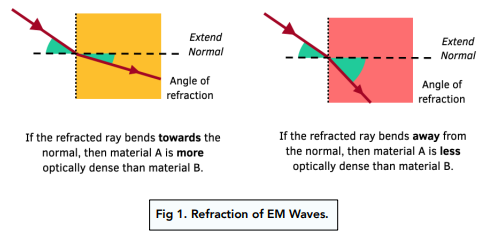
The refracted ray can bend towards the normal. If this happens, we know that material B is more optically dense than material A.
If the refracted ray bends away from the normal, then material A is less optically dense than material B.
Wave Front Diagrams
- Waves can change speed. As we have mentioned previously, waves can change velocity when crossing a boundary. Instead of using a simple ray diagram, we can also represent this using a wave front diagram, such as the one below. Refraction of wave fronts occurs only when the waves are at an angle to the boundary.
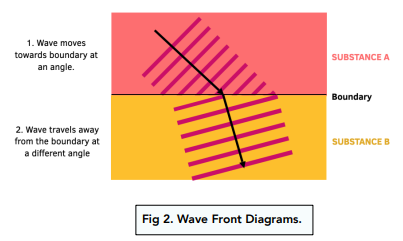
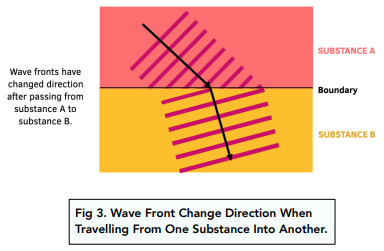
As we can see from the diagram above, the wave fronts have changed direction after passing from substance A to substance B.
If substance A is more optically dense than substance B, then the wave fronts will speed up as they cross the boundary, meaning that the fronts will get closer together.
If substance A is less optically dense than substance B, then the wave fronts will slow down as they cross the boundary, meaning that the fronts will get further apart.
Investigating Infrared Radiation
Method: Absorption
We can investigate the amount of infrared radiation absorbed by a surface using the following method.
- Gather the equipment. You will need two different cans, one with a shiny white surface and one with a matt black surface, two thermometers, some water, a measuring cylinder and a stopwatch.
- Set up the equipment. Place the same amount of cold water into each can, using the measuring cylinder. Put both cans into the sunlight.
- Place the thermometers into the cans. Place a thermometer into each of the cans. Record the temperature of each can of water and write it down.
- Wait for 20 minutes. Leave the cans in the sunlight for 20 minutes, measuring the time with a stopwatch.
- Record the temperature. After 20 minutes have passed, record the temperature of the water in each can and write it down.
- Calculate the increase. Now that you have an initial and a final temperature, you can calculate the increase in temperature. Simply subtract the initial temperature from the final temperature to get the rise in temperature. You can record your results in a table like the one shown below.
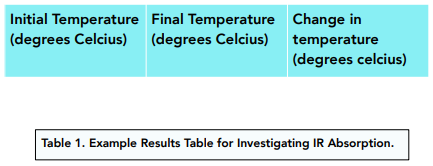
Method: Radiation
We can investigate the amount of infrared radiation radiated by a surface using the following method.
- Gather the equipment. You will need two different cans, one with a shiny white surface and one with a matt black surface, two thermometers, some boiling water, a measuring cylinder and a stopwatch.
- Set up the equipment. Place the same amount of boiling water into each can, using the measuring cylinder. Make sure that the two cans are stood next to each other.
- Place the thermometers into the cans. Place a thermometer into each of the cans. Record the temperature of each can of water and write it down.
- Wait for 20 minutes. Leave the cans for 20 minutes, measuring the time with a stopwatch.
- Record the temperature. After 20 minutes have passed, record the temperature of the water in each can and write it down.
- Calculate the decrease. Now that you have an initial and a final temperature, you can calculate the decrease in temperature. Simply subtract the final temperature from the initial temperature to get the fall in temperature. You can record your results in a table like the one shown below.
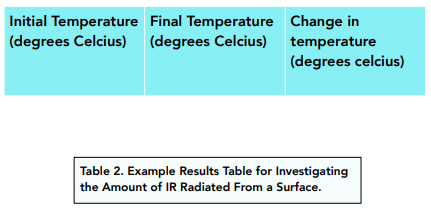





Still got a question? Leave a comment
Leave a comment